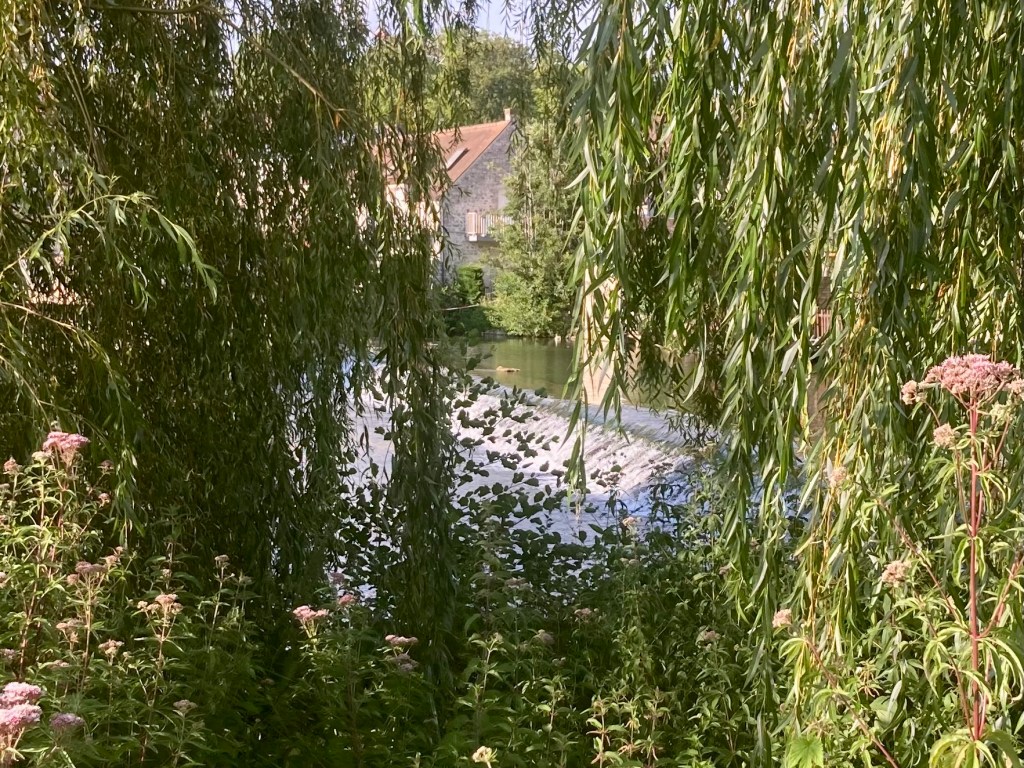18th to 23rd July 2023
At 49kms this must be one of the shortest canals in France, but that does not detract from its charm. I can feel myself being repetitive when I say that we have been surprised and captivated from Montargis to St-Mammés, where the river Loing joins the Seine.
It was built in under 5 years from 1719-24 by infantrymen ‘commandeered’ by the Duke of Orléans. He already had a canal, named after him, that ended at Montargis, so almost 50kms short of the Seine and therefore a connection with Paris.
It has an interesting history, originally utilising much more of the river Loing than now. Changes were made in the C19, bringing in more canal sections.



Montargis
We began at Montargis, where the Canal de Briare ends, and dovetails into Canal de Loing. We had spent a couple of fascinating days in Montargis – a place well worth a visit, and described in the previous blog post. Leaving town gave us a few new angles on bridges, waterways, and the old tower with its pigeon on guard in the arrow slit.
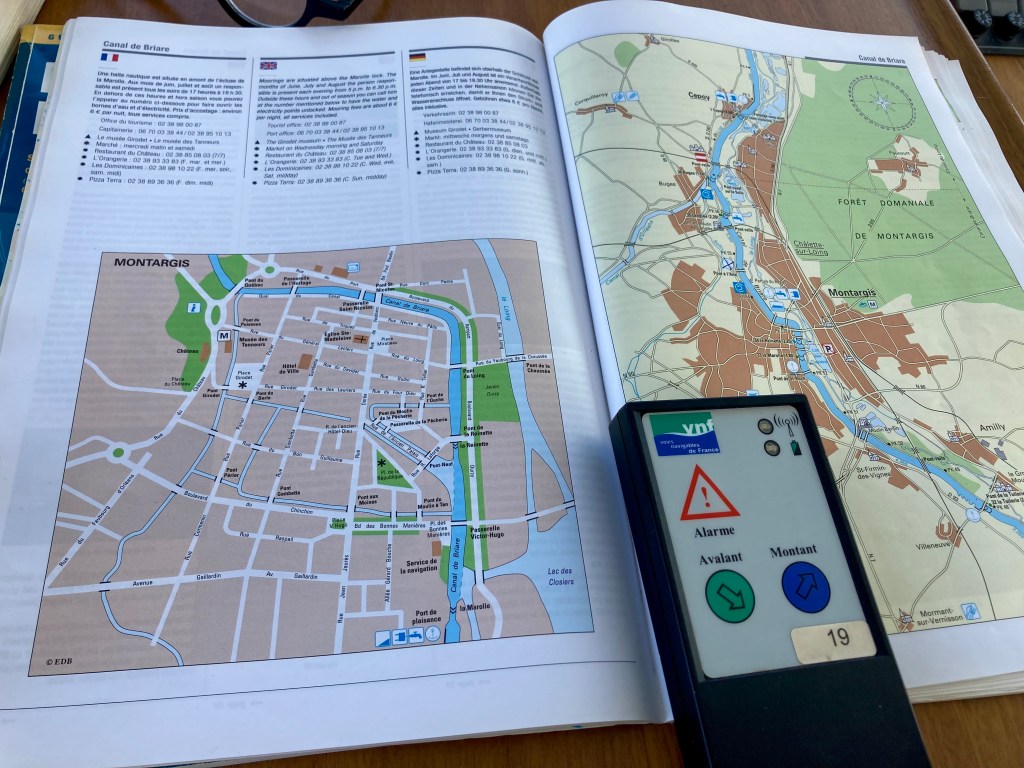
At the very first lock just 200 yards from where we had been moored we were handed our ‘zapper’, or remote control. These always come with mixed feelings. On one hand it is nice to be in charge of our own timings and lock operations, but on the other it means that yet more locks are automated, and more éclusiers (lock keepers) are out of a job.
In effect we become our own lock keepers.
Once in the lock we head for the long blue and red ‘poles’ that hang down from this sign, tie up and lift the blue pole ……. being careful not to pull the red pole in error as that signals an emergency.
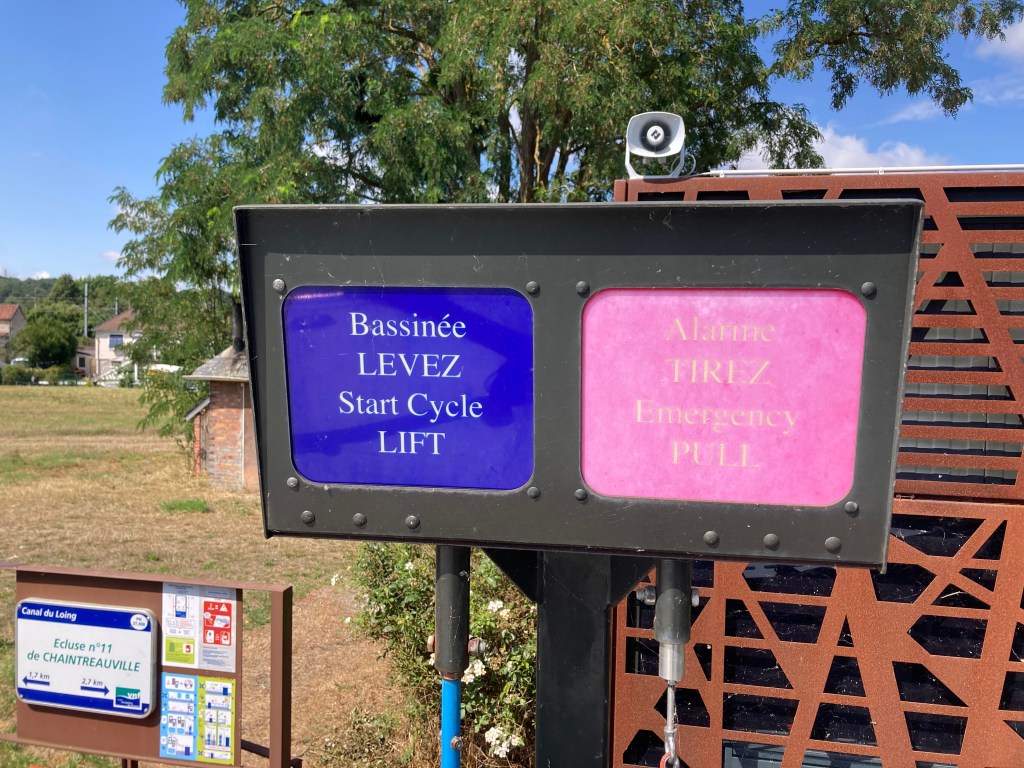
Cepoy

It did not take long to be out of town once more and into the villages – all with similarities and each one with differences.
This lock at Cepoy was next to a house where the owner kept birds next to a window – parrots or mynahs or something that likes to copy every sound it hears; an amusing cacophony.
We tried to work out which industry had demanded such a tall brick chimney on the past, but could not come up with an answer.


After the excitement of Montargis it was delightfully calm to be moored out in the country again. We stopped not far from Cepoy, just above ecluse 2 de la Vallée – and truly were out in the wilds!
In the morning we were off through écluse 2 after a leisurely breakfast, using our zapper to choose our own departure time. With the lovely éclusiers we have to decide the day before what time we will leave, and let them know, so this measure of independence is valued. Of course we can still only move during the day’s lock opening times, normally around 0800 to 1800, but varies from canal to canal.
So we were a bit surprised when we reached écluse 4 to find that our zapper had no effect – and that there was quite a crowd of men and work vans in the area.

One man walked towards us to let us know that there was an ‘issue’. A tree had fallen onto the electrics for the lock. Within half an hour the team had it sorted and we moved into the lock.
As we left the lock I snapped the new style lock office, including, on the smaller structure, the name and number of the lock – No.4 Retournée.


Near Néronville
Before too much longer we were at our next rural halt, near Néronville. This time we were moored next to some picnic table popular with passing cyclists so had fleeting company throughout our stay.
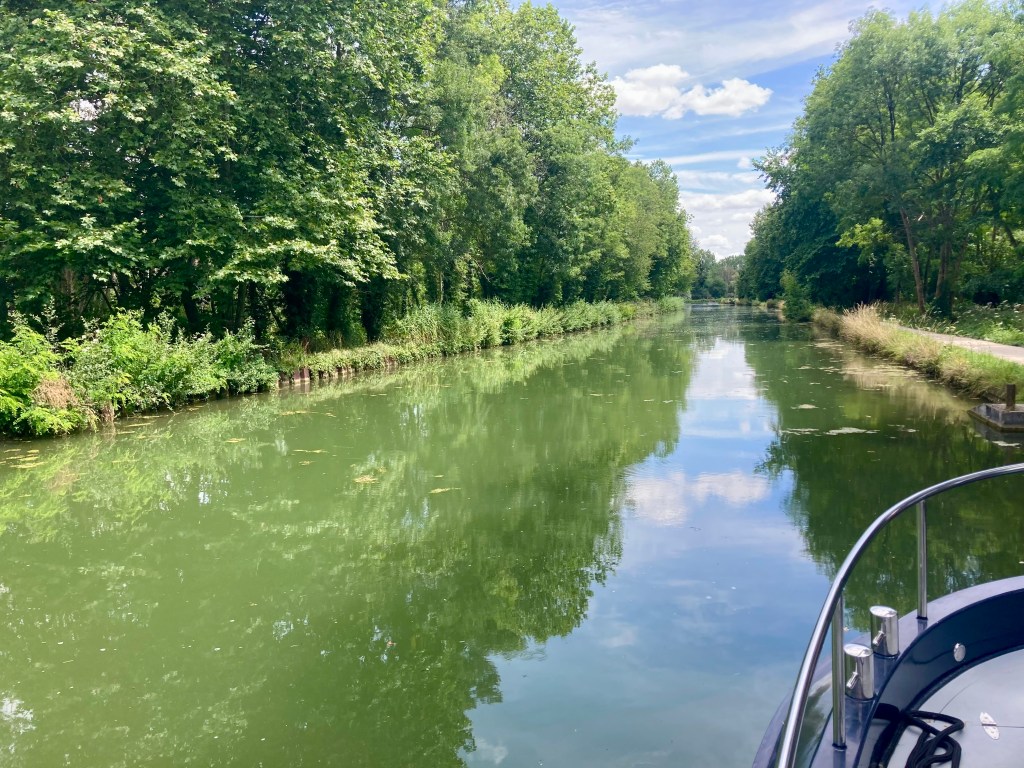
That did not spoil our enjoyment of the countryside.
By about 6pm we had the place to ourselves.
During the afternoon we went on an exploration walk through the woods. We were looking for the ruins of an old abbey.
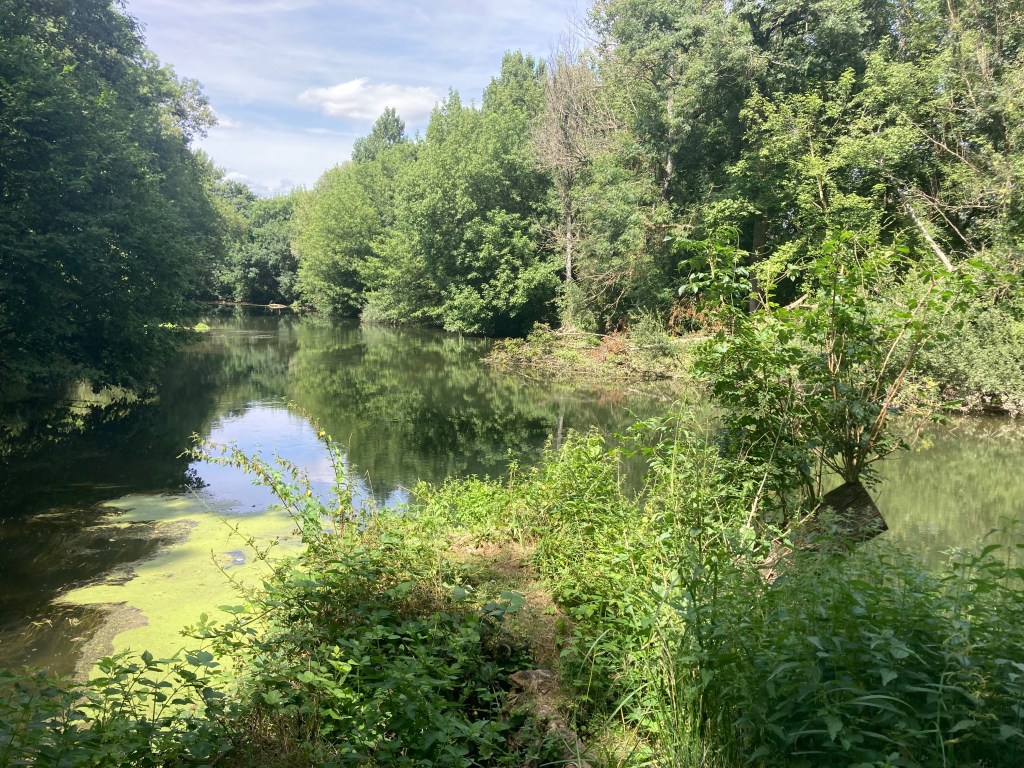
But instead we found the confluence of le Fusain and the Loing rivers.



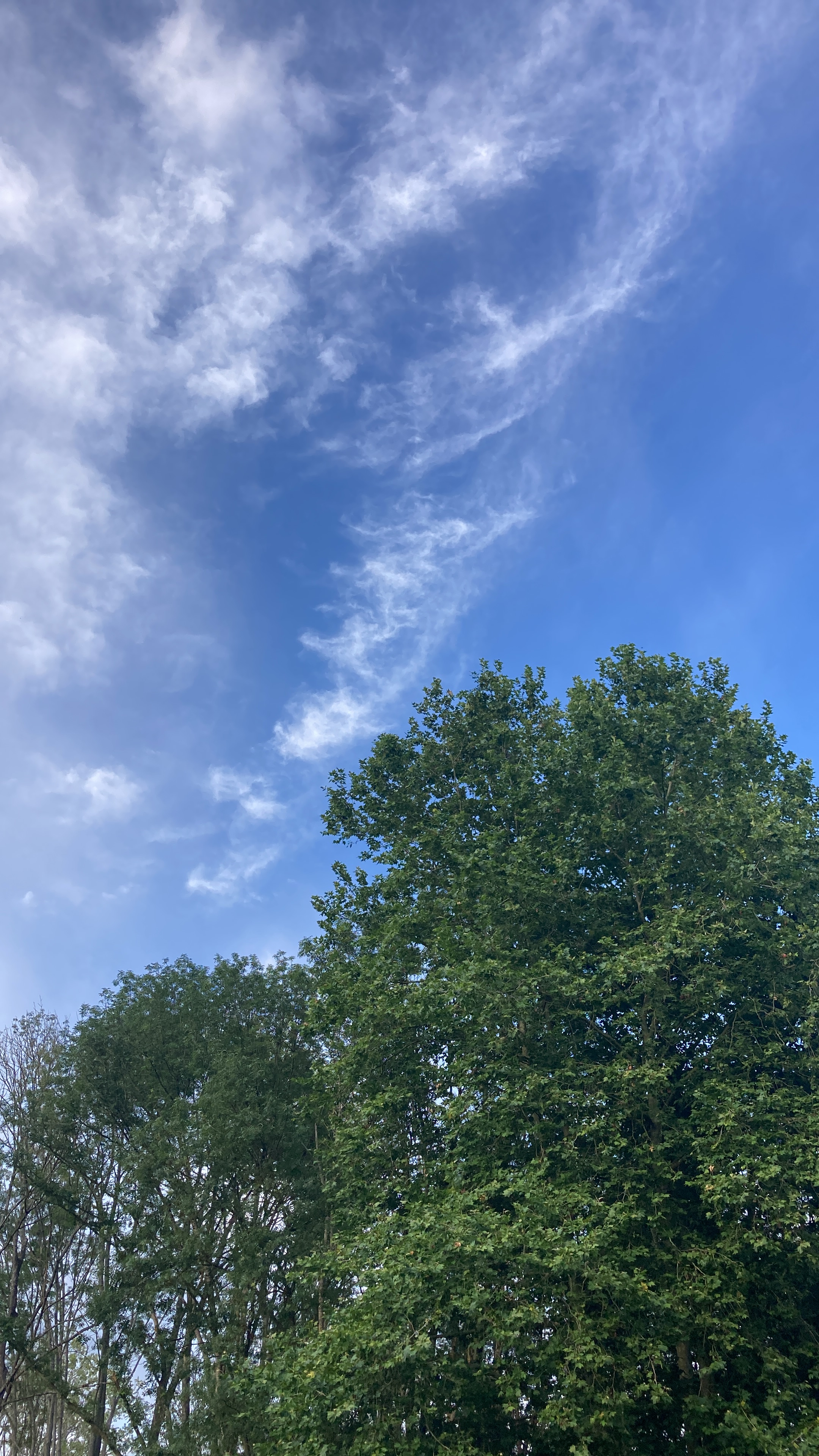
Our other ‘discoveries’ were a lovely hibiscus bush next to an abandoned lock keeper’s house, shoals of tiny fish (catfish?), and high wispy clouds drifting by, potentially sjgnalling a change in the weather.

And sure enough there was a change.
Next day saw me in sou’wester and waterproof hat!
But the weather did not detract from being out on deck and catching sight of a few more interesting things – or should I say things of interest to me, in case they don’t interest you?? Well here they are; skip over off not one of your topics.

Half way through the morning we came through what seems to be a very old and narrow bridge.
Just after the bridge there was a signpost to ‘Manoir de Beaumoulin’ on a private drive.
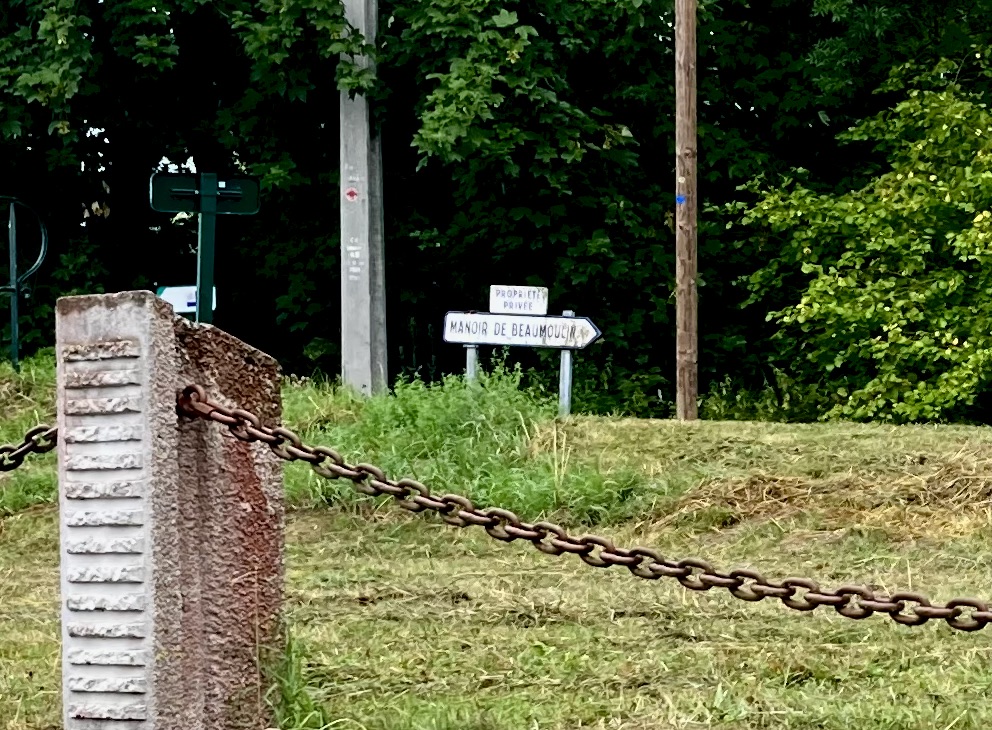
Those two observations must go together – an old bridge built to get the Manoir when the canal cut through the area, although not much to be seen of the manoir from the canal these days..

Something that was still in evidence on thnis part of the Loing was an ironwork an chjor motif.
I had first seen this white v version on a bar/gate at the lock the where we stayed the night before.




Then as we continued downstream towards Nemour I found a whole series of them, this time in rust red, making the wave formation under the bars much clearer. It must be linked ot the VNF in some way as they are all at locks, or at the approach to locks.
At last the clouds and rain of the morning had made way for bluer skies, and beneath us the waters became clearer too.


The water was so clear we could see the water weed growing healthily upwards, and fish swimming in and out of the fronds./
Of course weed is not something most boaters want to see in the canals and rivers. It can get would round propellors and, in the case of water cooled engines, clog up filters.
Luckily for us Calliope is keel cooled, a closed system, and generally a quick reverse on the engine throws any weed off the propellor.
Nemours
By now we were in Nemours where we planned to stay for 2 nights. There are three moorings listed for Nemours in the DBA Waterways Guide (Dutch Barge Association). We thought that the first one we would reach would suit Calliope best.

It was just right. The bollards were the right distance apart for us and the height of the wall we were moored against made it easy to step ashore. It was also a short stroll along the bank in either direction to bridges that led into different areas of town.

Nemours was yet another town full of pleasant surprise.
The centre is pleasingly old, its streets lined with shops, homes, auberges and churches that have stood there for centuries.
Painted doorways hinted at ancient rooms and courtyards beyond, but these were private and could not be explored.
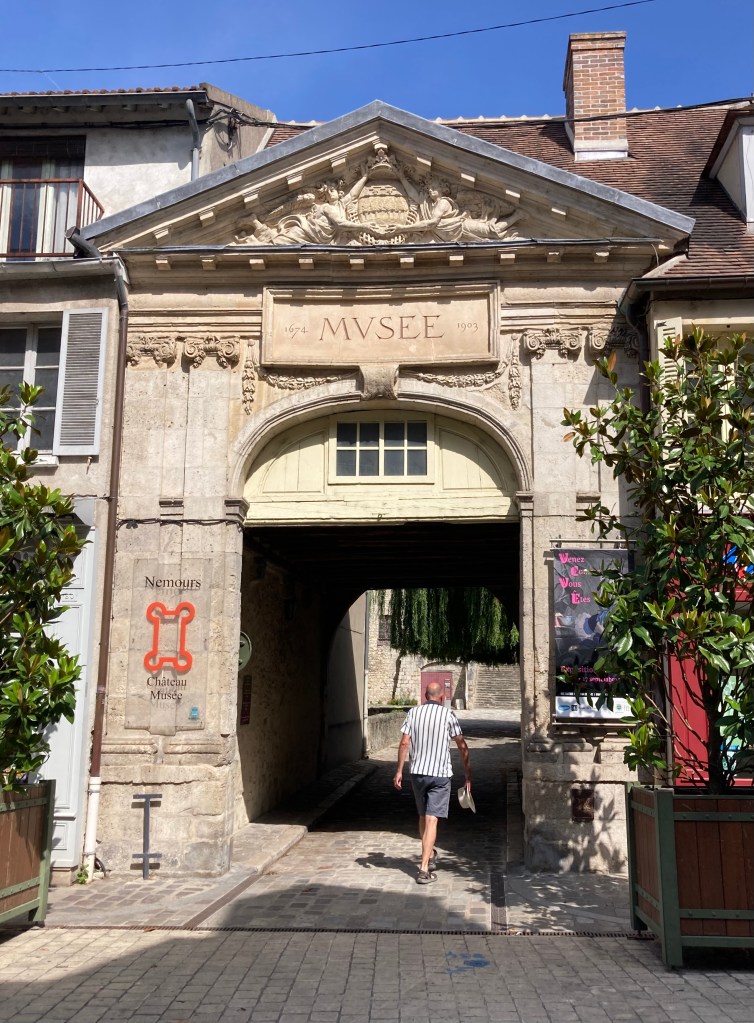
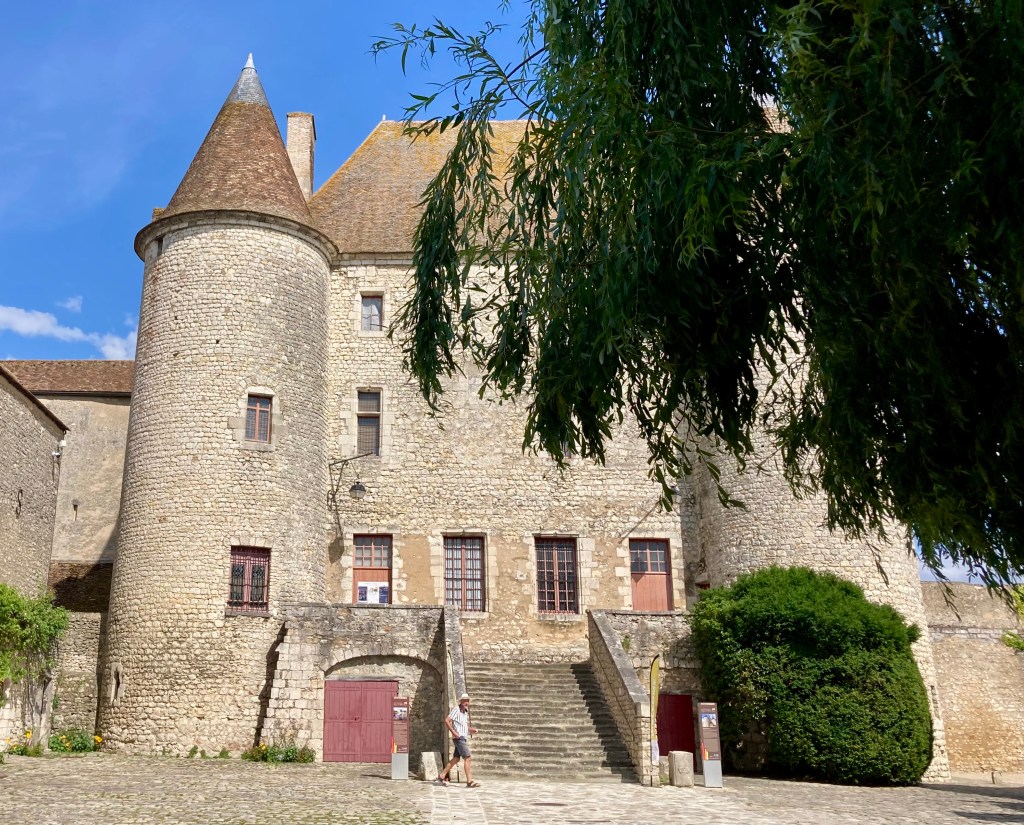

The centrepiece is the chateau, now housing the museum. It was built in the mid-12th century by Gauthier I of Villebéon, Grand Chamberlain of kings Louis VII and Philippe Auguste. Since then it has been substantially restored and altered over the centuries, with final major restructuring by Philip of Orléans, in the time of his brother Louis XIV.
After the French Revolution, the castle was owned by the town, which decided to open a museum there in 1901.
And that is the use that has continued to the current day.


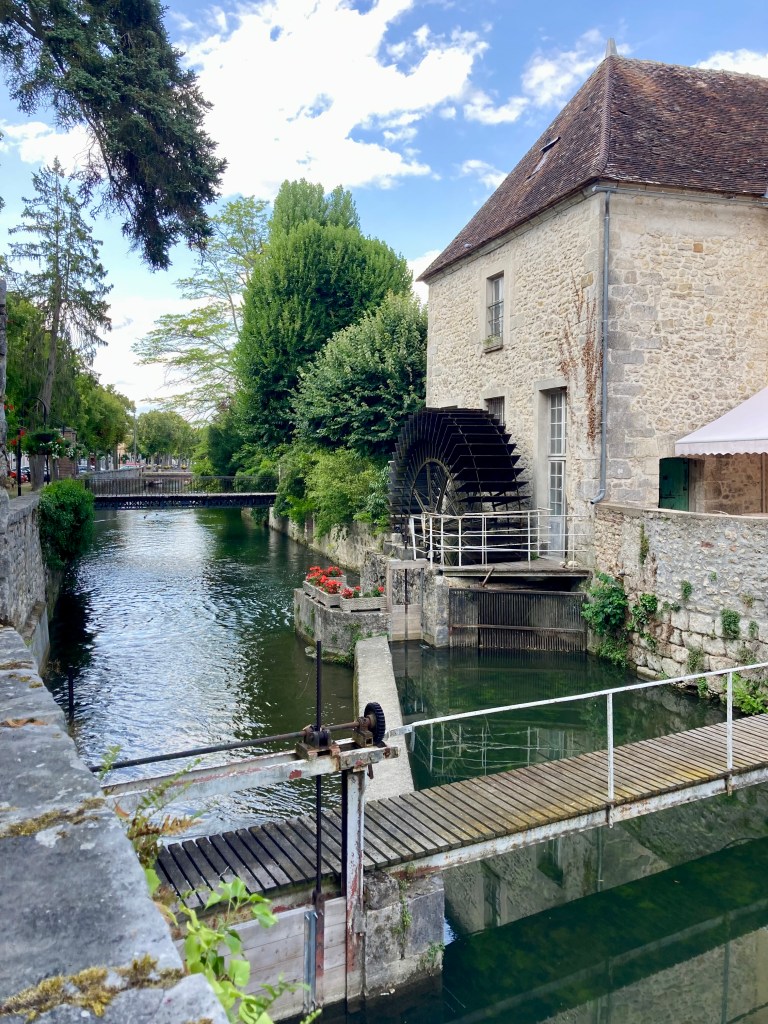


Several waterways cut through the town. The church is on the banks of the Loing; watermills and lavoirs used to line the small branch of the river that runs along the West and North edges of the old town; and the canal that we were travelling is the third main water artery.

There is one huge watermill that still remains.
And its big old quay on the side of the Loing have been put to a new use.
In the summer it plays host to an open air food and drink court! Just the place on a warm July evening for Stewart and I.



After a beer on the grassy banks we explored the food offerings and settled on a freshly made savoury galette each, with a glass of local wine.
We had a really enjoyable early evening out.


So two days very well spent in Nemours and then it was time to continue to the end of the canal at Moret-sur-Loing where we had booked in for 3 nights.
Moret-sur-Loing

As we left Nemours we were quickly out onto the wider margins of thew river again. The Loing was flowing well and we moved along under greyish clouds at a good pace.
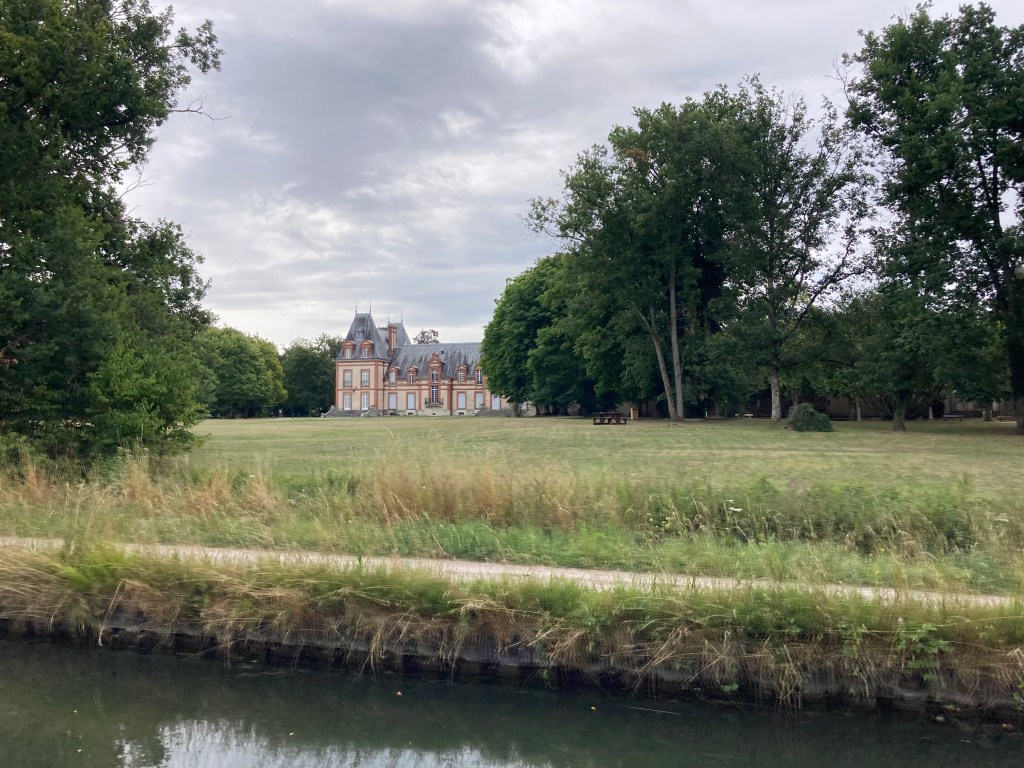
The morning’s run was almost entirely through the countryside, with the occasional grand house v viewed across the grasslands.
Some were still private residences and others seemed turned into communal use such as libraries.

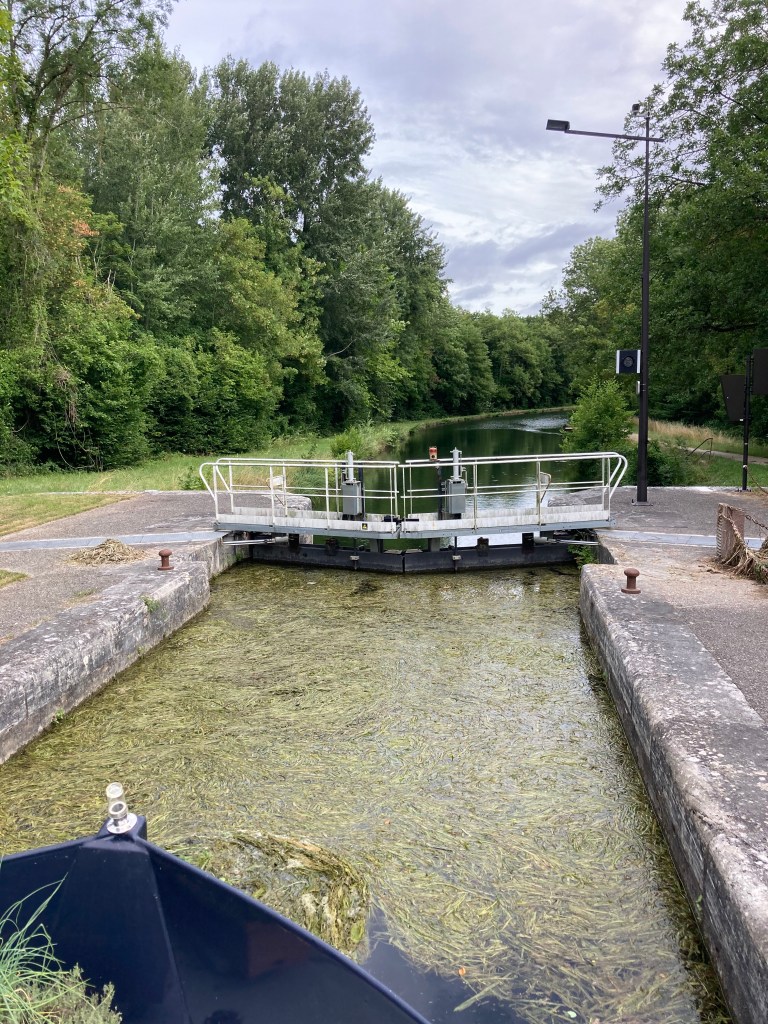
Around Écluse de Berville the water weed became a lot thicker, parting in our wake and gathering before us.
We did not pass many craft that day, but one that caught our eye was Interlock. She was like a garden studio on a floating platform, powered by two outboard motors.
Her progress was steady and gentle, and at a distance we did wonder what was coming towards us!

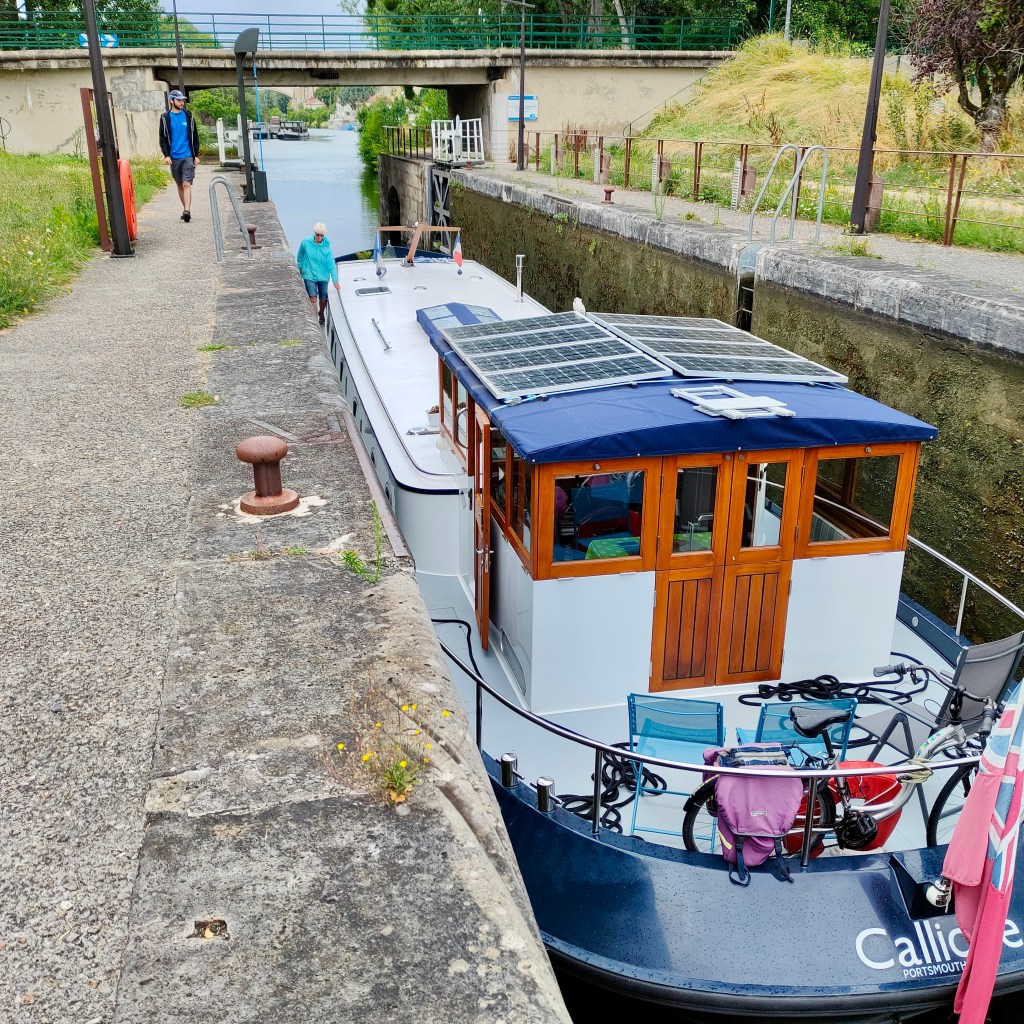
We were pleased to reach our last lock just before lock keeper’s lunchtime! This lock took us down from the canalised section and back onto the Loing river.
It had just started to rain, so it looked like good timing. Moret was directly ahead of us and we expected soon to be tied up comfortably and eating our own lunch.
But arriving at Moret was a bit more interesting than that.
We had booked our place for three nights and arrived at about noon hoping/expecing that our mooring would be there for us. It turned out that the boat whose space we were taking was not planning to go until 4pm, and there was virtually nowhere to moor up and wait.

However we managed to get on to the little waiting pontoon for the lock and tucked into our lunch before waiting a couple of hours watching the river flow by. At the same time we kept our eye on the other boat acrosss the river.

Luckily they saw us waiting and got ready to leave earlier than they had planned.
They set off at 3pm and we quickly moved into our hew temporary home.

The pontoon layout at Moret is different – three pontoons at a very small angle to the river bank. It is hard to explain and show, but here we are on the outside of pontoon 1, and sister ship Ettie arrived later to moor on the inside.
The weather while we were in Moret was more April than August, with heavy down pours interspersed with warm sunshine. My photos show this contrast rather well – some grey-skied and some blue.
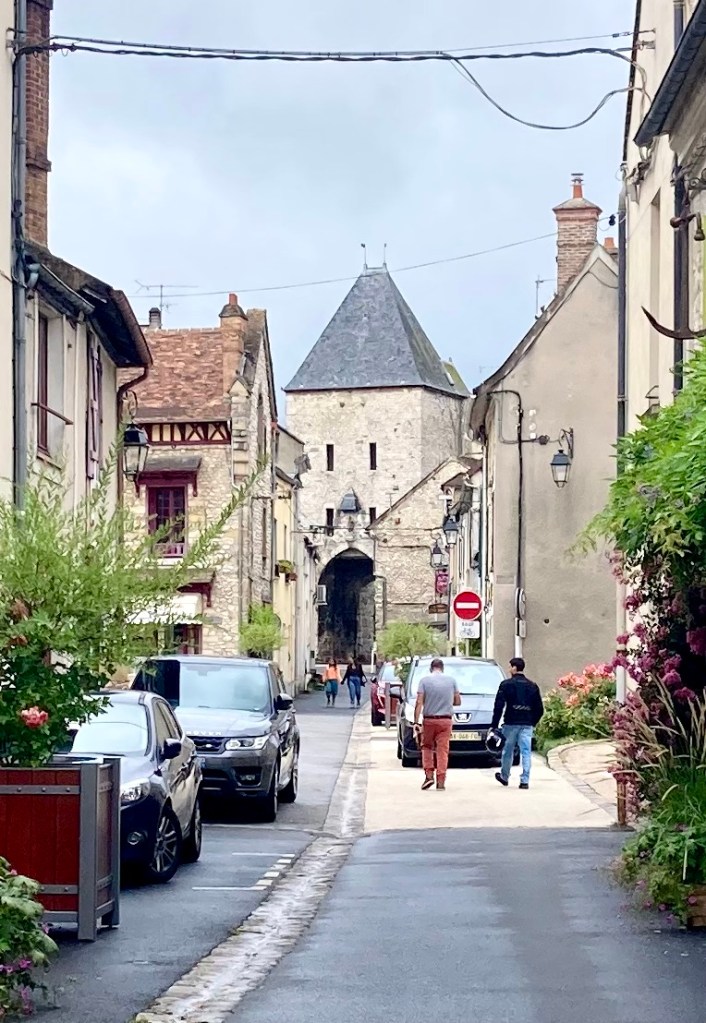


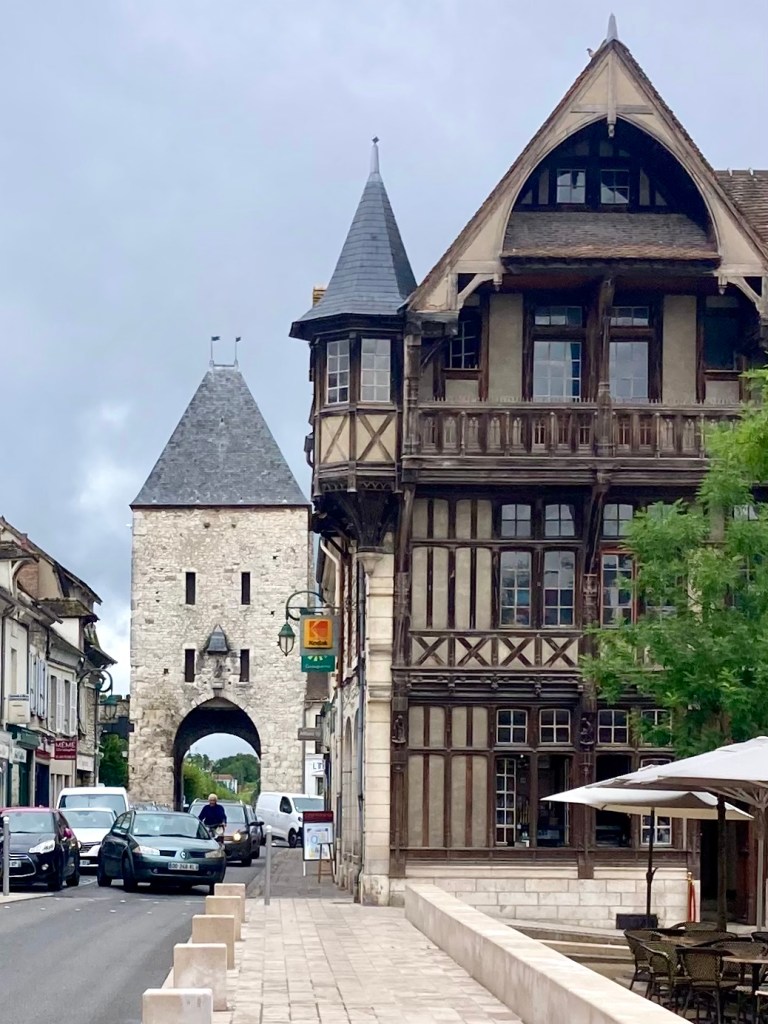
There are many old gates into Moret-sur-Loing; some are watergates onto the river and others lead to roads. The latter’s names explain the direction they face – Porte de Samois, Porte de Borgogne.


Once again there are so many old buildings that I am just giving a taster her – the Sugar Museum on the left and the church on the right.
There was quite big collection of friendly boaters moored up and it wasn’t long before discussions were going on to plan a social get together.
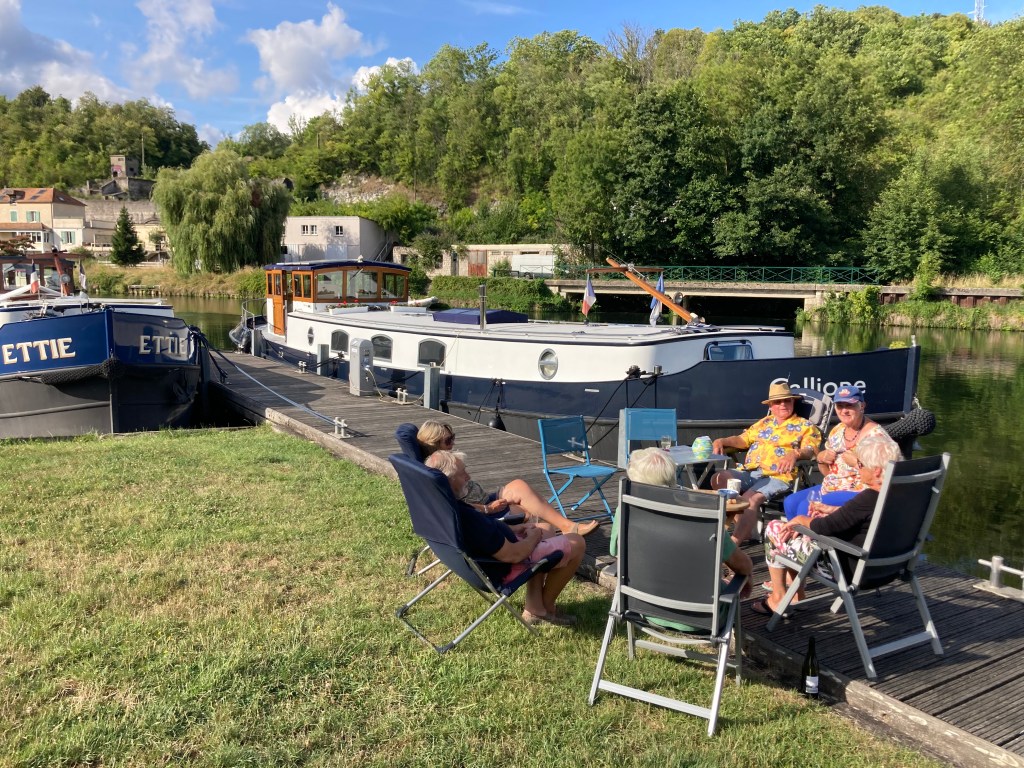
We all agreed that none of us had a big enough back deck for everyone to gather so a pontoon party was organised to take place between the showers. And here we are, (except Stu and I) managing a bit of fun before the next thundershower arrived.
The one wondrous occurrence on a day full of showers an d sunshine is the chance of a rainbow, and we were not disappointed.



Undeterred we contnueds shopping and were rewarded by a good haul of food for lunch.
For those who are wondering, the cheeses are Stu’s favourite Saint Félicien, and my favourite Brebis et Chèvre (sheep and goat). The patés are a local Moret rough textured paté, forestière, and paté de tête. You can also see a good gruyère fougasse, fresh tomatoes and radishes, and a crusty baguette. Yum yum.

Our last evening on the Loing brought the setting sun’s rays almost horizontally across the river, picking out some of the boats on the other bank and lighting them up in golden red tones .
There is something magical about the combination of light and water.

The day of our departure both from Moret and from the Canal / River Loing came in blue. The park next to the mooring was quiet and green. All was set fair for Calliope and crew.
We had a send off from some of our pontton party mates, with many a shout of ‘see you again soon’.

And a quieter goodbye from a local plover.

Then we were off, away down the short final stretch of the Loing, to its junction with the Seine, where we turned to starboard, away from Paris and towards some much bigger barges!

A couple of hours on the Seine
Most people know the Seine because it flows through Paris. We have often discussed whether we should take Calliope into Paris, just for nthe experience. Many boaters say it is wonderful, if a bit expensive for mooring. Somehow we always end up deciding that we would rather cruise and see the ‘backwaters’ of France that we have never seen or heard of before. Hence we turned to starboard and headed for the Yonne – just over two hours up stream.
But whilst on the Seine we were acutely aware that this is a major thoroughfare for transporting goods to and from the capital – and beyond.

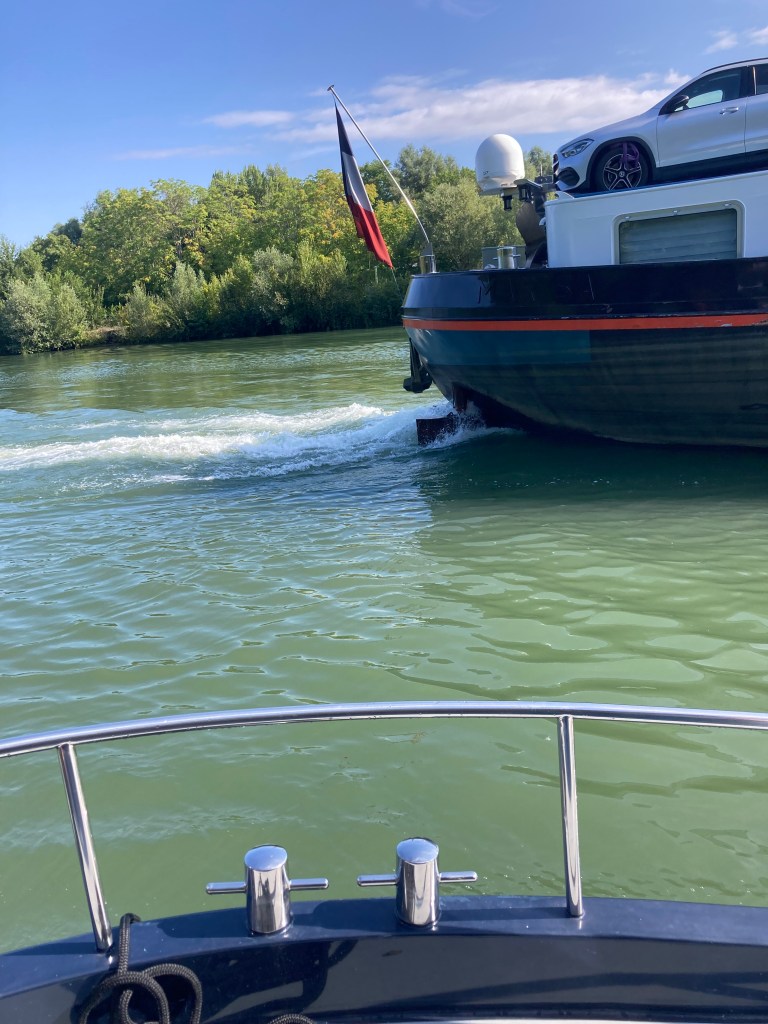

There is something majestic about the power and fluidity with which these huge barges move through the river. We never tire of seeing them – and on the Seine there is plenty of room for us both. The Captains are usually friendly, waving as we pass each other.


We had just the one lock to go up. The actual rise was not much, but the other dimensions of the lock, ready to accommodate the huge working barges, seemed enormous when we were in there alone.
First we had a short wait outside the lock, where the bollards are set for much larger boats than Calliope! But all was fine and we tied up to wait our turn.

Soon after the lock we cxamwe to Montereau-Fault-Yonne, where the Yonne flows into the Seine. Turning to go under the bridge we began our next exploration – to be written up in the next blog.

